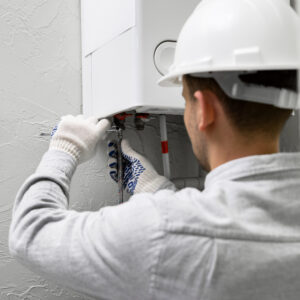In a striking demonstration of next-gen robotics, Infineon and HTEC unveiled a 360° awareness humanoid robotic head at the OktoberTech Silicon Valley 2025 show, a development that earned the coveted Partner Innovation Award for its human-interactive, multi-sensory capabilities.
Featuring a multi-sensory perception system, real-time spatial understanding, and adaptive human-interactive behaviors, the robotic head serves as a defining example of how next-generation robotics will bridge the gap between mechanical systems and natural human perception. More than a visually impressive demonstration, the project represents a powerful reference design that could influence the architecture of future autonomous machines, service robots, smart assistants, and security technologies.
A Landmark Milestone in Multi-Sensory Robotics
Infineon and HTEC’s achievement marks a significant leap in how robots can sense and interpret the world. While robotics has long incorporated cameras, microphones, or isolated sensing mechanisms, this humanoid robotic head integrates multiple sensing modalities—spatial, depth, visual, and auditory—into a unified real-time intelligence framework.
This integration allows the system not only to collect data but to interpret it cohesively, much like human sensory processing.
At the Heart of the System: Infineon’s Advanced Sensing Technologies
The robotic head is powered by a suite of Infineon’s highest-precision sensors, including:
✔ XENSIV™ 60 GHz radar sensors – providing advanced spatial awareness, distance perception, movement tracking, and environmental mapping.
✔ REAL3™ Time-of-Flight (ToF) depth-sensing technology – enabling 3D vision, object detection, and highly accurate depth measurement for real-time situational analysis.
✔ MEMS digital microphones with high sensitivity – capturing directional sound, enabling the robot to locate, turn toward, and respond to audio cues.
These sensing systems are supported by embedded AI and sensor-fusion algorithms developed collaboratively by Infineon and HTEC’s engineering teams. Together, the hardware and software enable the robotic head to combine auditory, visual, and spatial inputs into a seamless, context-aware understanding of its surroundings.
The result is a system capable of:
-
Detecting human presence
-
Turning toward voices or sounds
-
Mapping environments in 3D
-
Recognizing depth and distance
-
Reacting to movement around it
-
Understanding context in real time
Such capabilities mark an important step in robotics—a move from raw sensing to genuine perception.
A Breakthrough Made Possible Through Deep Collaboration
The robotic head represents the culmination of a long-standing technical partnership between Infineon and HTEC. What makes this collaboration exceptional is the fusion of Infineon’s hardware innovation with HTEC’s industry-leading systems engineering, embedded development, AI expertise, and product design.
Sensor Fusion + Embedded Intelligence = Human-Like Understanding
HTEC’s engineering teams worked closely with Infineon’s sensing experts to develop:
-
Embedded firmware
-
AI-based perception logic
-
Sensor-fusion algorithms
-
Real-time event processing
-
Mechanical and system integration
Together, these components allow the sensors to operate in unison, interpreting data to produce actionable intelligence. Instead of viewing the environment through isolated lenses—for example, radar for distance and microphones for sound—the robot processes all incoming data streams simultaneously.
This mirrors the human brain’s ability to connect sight, sound, depth, and spatial awareness into a single cohesive perception. Such multi-modal understanding represents the next frontier of robotics innovation, enabling machines to interact with people more naturally and intelligently.
From an Impressive Demo to Real-World Transformations
Although the humanoid robotic head was unveiled as a demonstration, its impact extends far beyond the OktoberTech stage. It is designed as a reference architecture—a flexible technological foundation that can be integrated into numerous robotics and automation solutions.
Potential Real-World Applications
The platform’s multi-sensory intelligence opens opportunities across industries, including:
1. Elderly Care and Assisted Living
Robots equipped with 360-degree awareness can:
-
Recognize when a person enters a room
-
Detect falls or unusual sounds
-
Respond to voice commands
-
Track movement to ensure safety
Such capabilities can empower assistive robots to deliver safer, more reliable support.
2. Autonomous Delivery and Service Robotics
Delivery robots operating in urban or indoor environments require precise environmental sensing to avoid obstacles, maps spaces, and recognize humans. This reference design could accelerate development of:
-
Hospital delivery robots
-
Hotel service robots
-
Retail inventory robots
-
Last-mile delivery systems
3. Smart-Home Assistants
The technology could become the backbone for next-gen smart-home devices capable of:
-
Recognizing household members
-
Responding to multi-directional audio cues
-
Interacting naturally with users
-
Monitoring environments for security
4. Advanced Security and Surveillance Systems
Security robots demand precise situational awareness. The 360-degree sensory perception enables:
-
Directional audio detection
-
Motion and depth recognition
-
Adaptive responses to environmental changes
-
Multi-angle monitoring
5. Industrial Automation
Factories could use context-aware robotic systems that:
-
Navigate complex layouts
-
Detect dynamic hazards
-
Interact safely with human workers
-
Adapt to changing surroundings
In each of these scenarios, the humanoid head transitions from a demo to a modular intelligence engine capable of powering sophisticated robotic applications.
Why This Innovation Matters for the Future of Robotics
The demonstration showcased at OktoberTech 2025 is more than a technological milestone—it represents a shift in the fundamental capabilities expected from robots of the future.
1. Robots That Don’t Just Operate—They Understand
Traditional robots excel at mechanical tasks but struggle with environmental awareness. By combining spatial sensing, depth vision, audio localization, and AI-driven interpretation, Infineon and HTEC are demonstrating the next evolution: robots that truly perceive.
2. Humans and Robots Working Together
As industries adopt collaborative robots (cobots), human-robot interaction becomes a critical focus. The ability to recognize and respond to humans through intuitive cues—sound, presence, movement—will enable more natural, safer integration of robots in workplaces, homes, and public spaces.
3. Accelerated Innovation Through a Reference Design
By presenting the humanoid robotic head as a reproducible blueprint, Infineon and HTEC are reducing the barriers for developers, startups, and OEMs. Instead of building intelligence architectures from scratch, innovators can adapt this platform to new applications, leading to:
-
Faster product development
-
Cost savings
-
Standardized interoperability
-
A more robust robotics ecosystem
4. Moving Toward Context-Aware Autonomous Machines
The integration of radar, ToF sensors, audio intelligence, and AI brings robotics closer to achieving contextual awareness—a foundational requirement for autonomous systems operating safely in unpredictable environments.
Voices From Infineon and HTEC
Leadership from both companies emphasized the transformative potential of this innovation.
Infineon’s Perspective
Raul Hernandez Arthur, Head of SURF Enablement at Infineon, highlighted that the project offers a glimpse into the future of robotics. He emphasized that combining Infineon’s advanced sensing portfolio with HTEC’s engineering capabilities unlocks enormous opportunities across industries that depend on reliable, intelligent robotic systems.
HTEC’s Perspective
Dejan Pokrajac, Senior Client Partner at HTEC, described the project as a blueprint for next-generation, context-aware robotics, showcasing how industry collaboration can create solutions that push boundaries far beyond traditional automation.
Both leaders reaffirmed their commitment to continued joint innovation and to supporting the next wave of robotics evolution.
A Major Step Toward Robots That Sense, Interpret, and Respond Like Humans
The debut of the humanoid robotic head at OktoberTech 2025 signals a monumental advancement in robotics engineering. Through the integration of precise sensors, advanced AI, and high-performing embedded systems, Infineon and HTEC have engineered a platform with the potential to redefine how robots understand the world.
More importantly, the system’s flexibility ensures that it can evolve as industries continue to adopt intelligent automation. From elder care to retail, from manufacturing to home environments, the implications of this innovation are profound.
Looking Forward
As AI advances and sensor technologies improve, robots will increasingly embody capabilities once limited to science fiction—perceiving their environment with nuance, reacting to human cues, and operating with high degrees of independence. The Infineon-HTEC robotic head is a crucial step toward that future, offering a foundation on which countless innovations can be built.
Discover IT Tech News for the latest updates on IT advancements and AI innovations.






